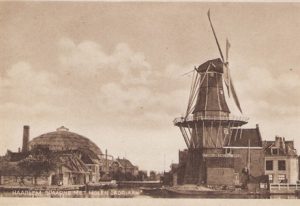


The city provides, under pressure from various organizations, one million guilders for the rebuild of De Adriaan. The total cost are 2.5 million guilders. With support from The European Union and various subsidies the implementation of the plans for rebuilding get a lot closer. Businesses, sponsors and residents of Haarlem provide approximately NLG 900 000, – for the rebuild.
The population of Haarlem wants De Adriaan back; the last city mill of Haarlem deserves its own spot on the river Spaarne. Because of the Great Depression and the Second World War the politicians make different choices.
“De vereniging Haerlem” and the “Association of the Dutch Windmill” continues to promote rebuilding the mill. In 1953, they hope to rebuild the mill with the idea to bring a café in the base. That initiative failed.
 On April 23, 1932 De Adriaan catches fire. Thousands of Haarlemmers watch helplessly as it goes up in flames.
On April 23, 1932 De Adriaan catches fire. Thousands of Haarlemmers watch helplessly as it goes up in flames.
The extinguishing lasts for days.
 In 1925 the Association “De Hollandsche Molen” bought De Adriaan.
In 1925 the Association “De Hollandsche Molen” bought De Adriaan.
Grinding flour continues until the mill is severely damaged in 1930 by a storm.
Privacy | Copyright © 2020 Molen De Adriaan. Designed by Partiee